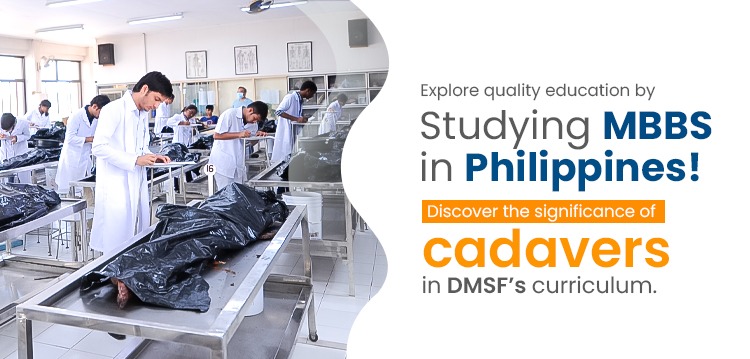
Explore quality education by studying MBBS in Philippines!
Discover the significance of cadavers in DMSF’s curriculum.
In medical education, a cadaver refers to a human body that has been donated for anatomical dissection and study by medical students. Cadavers play a crucial role in teaching anatomy, as they provide students with a realistic and hands-on learning experience. Through the dissection of cadavers, students gain a deep understanding of human anatomy, including the structure and organisation of tissues, organs, and systems. Working with cadavers allows students to observe the variability and intricacies of the human body, enhancing their knowledge and clinical skills. The study of cadavers promotes a respectful and ethical approach to understanding the human body and prepares students for future medical practice.
Significance of studying medicine using cadavers
Cadavers serve various important purposes in medical education. Here are some of the key uses of cadavers in medical education:
1. Anatomy study: Cadavers are invaluable for teaching human anatomy to medical students. Through dissection, students can explore and understand the three-dimensional structure and relationships of organs, tissues, muscles, and other anatomical structures. Cadavers provide a hands-on learning experience, allowing students to examine and appreciate the complexity and variability of the human body.
2. Surgical training: Cadavers are used for surgical training and practice. Medical students and aspiring surgeons can practice surgical techniques, such as suturing, incisions, and dissections, on cadavers before performing procedures on living patients. This hands-on experience helps develop surgical skills, hand-eye coordination, and a deeper understanding of the surgical anatomy.
3. Medical research: Cadavers are utilized in medical research to advance scientific knowledge and improve medical treatments. Researchers can study the effects of diseases, investigate anatomical variations, and develop new surgical techniques or medical devices using cadaveric specimens.
4. Clinical skills training: Cadavers provide an opportunity for medical students to practice various clinical skills, such as physical examination techniques, injection procedures, and airway management. This training enhances students' ability to diagnose and treat patients effectively.
5. Professionalism and empathy development: Working with cadavers allows medical students to develop professionalism, respect, and empathy towards deceased individuals. It instils a sense of responsibility and ethical conduct in handling human bodies, teaching students the importance of treating patients with dignity and reverence.
Overall, the use of cadavers in medical education is crucial for providing hands-on learning experiences, enhancing anatomical knowledge, developing surgical skills, conducting medical research, and fostering professionalism among future healthcare professionals.
Cadavers at DMSF
Davao Medical School Foundation (DMSF) added cadavers to their curriculum to enhance the hands-on learning experience for medical students, allowing them to gain a comprehensive understanding of human anatomy and develop essential clinical skills. Working with cadavers provides a realistic and immersive environment for students to explore the intricacies of the human body, preparing them for future medical practice with a strong foundation in anatomical knowledge.
